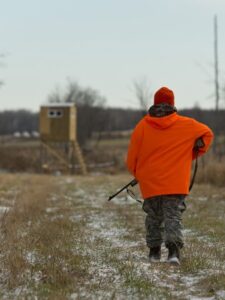
Choosing the right location for your deer blind is a critical aspect of a successful hunting strategy. A well-placed deer blind not only provides concealment but also increases your chances of encountering game.
Understand Deer Behavior
Before selecting a spot for your deer blind, it’s essential to understand the behavior of the game you’re hunting. Deer follow specific patterns based on feeding, bedding, and movement. Research the local deer population to identify their favorite trails, feeding areas, and bedding spots.
Scouting for Signs
Conduct thorough scouting in the area where you plan to set up your deer blind. Look for signs such as deer tracks, droppings, rubs, and scrapes. These indicators can help you pinpoint high-traffic areas and identify the most promising locations for your blind.
Wind Direction Matters
Pay close attention to wind direction when choosing a location for your deer blind. Deer have a keen sense of smell, and if the wind carries your scent towards them, your chances of a successful hunt decrease significantly. Position your blind downwind from where you expect deer to approach.
Water Sources and Food Plots
Deer are drawn to water sources and food plots, especially during specific times of the year. Set up your blind near these locations to increase your chances of encountering game. Make sure your blind offers good visibility of these areas while maintaining proper concealment.
Time of Day Considerations
Different locations may be more or less effective depending on the time of day. Morning hunts near bedding areas or travel routes to feeding areas can be productive, while evening hunts near feeding areas or travel routes to bedding spots may yield better results. Adapt your blind placement to the time of day you plan to hunt.
Use Natural Cover
Whenever possible, use natural cover to conceal your deer blind. Position it near trees, bushes, or other vegetation that can break up its outline and make it less noticeable to approaching deer. This natural camouflage enhances the effectiveness of your setup.
Accessibility and Safety
While focusing on optimal hunting locations, also consider the practical aspects of accessing your blind safely. Choose spots that are easily accessible without disturbing the surrounding area. Ensure your blind placement aligns with local hunting regulations and prioritizes safety.
Mastering the art of selecting the right location for your deer blind requires a combination of knowledge, observation, and strategic thinking. By understanding deer behavior, scouting effectively, and considering factors like wind direction and time of day, you can significantly increase your chances of a successful hunt. Remember, the best deer blind location is not just where you want to be but where the deer want to be. Happy hunting!
Contact Hunting Deer Blinds at 989-727-4902 today or visit us online for more information about our custom hunting deer blinds!


Leave a Reply
You must be logged in to post a comment.